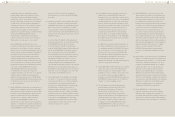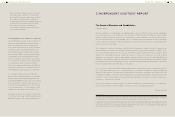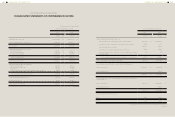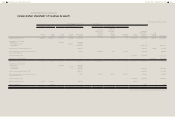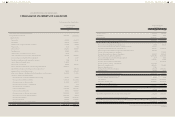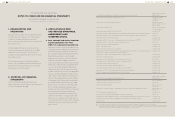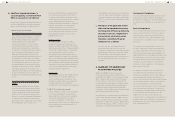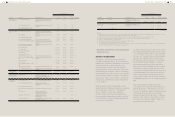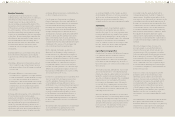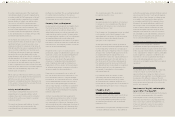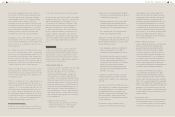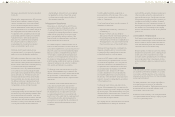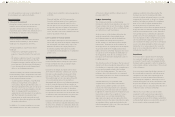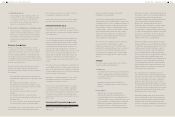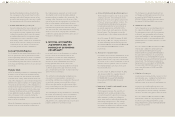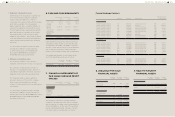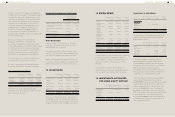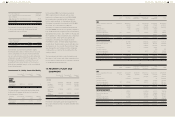HTC 2013 Annual Report Download - page 130
Download and view the complete annual report
Please find page 130 of the 2013 HTC annual report below. You can navigate through the pages in the report by either clicking on the pages listed below, or by using the keyword search tool below to find specific information within the annual report.
FINANCIAL INFORMATION FINANCIAL INFORMATION
256 257
Foreign Currencies
In preparing the financial statements of each
individual group entity, transactions in currencies
other than the entity's functional currency
(foreign currencies) are recognized at the
rates of exchange prevailing at the dates of the
transactions. Functional currency is the currency
of the primary economic environment in which
the entity operates. At the end of each reporting
period, monetary items denominated in foreign
currencies are retranslated at the rates prevailing
at that date. Non-monetary items carried at fair
value that are denominated in foreign currencies
are retranslated at the rates prevailing at the
date when the fair value was determined. Non-
monetary items that are measured in terms
of historical cost in a foreign currency are not
retranslated.
Exchange differences on monetary items arising
from settlement or translation are recognized
in profit or loss in the period in which they arise
except for:
a. Exchange differences on transactions entered
into in order to hedge certain foreign currency
risks (please refer to Note 4 "Hedge accounting"
section); and
b. Exchange differences on monetary items
receivable from or payable to a foreign operation
for which settlement is neither planned nor likely
to occur in the foreseeable future (therefore
forming part of the net investment in the foreign
operation), which are recognized initially in other
comprehensive income and reclassified from
equity to profit or loss on disposal of the net
investments.
Exchange differences arising on the retranslation
of non-monetary assets (such as equity
instruments) or liabilities measured at fair value
are included in profit or loss for the period at the
rates prevailing at the end of reporting period
except for exchange differences arising on the
retranslation of non-monetary items in respect of
which gains and losses are recognized directly in
other comprehensive income, in which case, the
exchange differences are also recognized directly
in other comprehensive income.
For the purposes of presenting consolidated
financial statements, the assets and liabilities of
the Company's foreign operations are translated
into New Taiwan dollars using exchange rates
prevailing at the end of each reporting period.
Income and expense items are translated at the
average exchange rates for the period, unless
exchange rates fluctuate significantly during that
period, in which case the exchange rates at the
dates of the transactions are used. Exchange
differences arising, if any, are recognized in other
comprehensive income and accumulated in equity
(attributed to the owners of the Company and
non-controlling interests as appropriate).
On the disposal of a foreign operation (i.e. a
disposal of the Company's entire interest in a
foreign operation, or a disposal involving loss of
control over a subsidiary that includes a foreign
operation, a disposal involving loss of joint control
over a jointly controlled entity that includes a
foreign operation, or a disposal involving loss
of significant influence over an associate that
includes a foreign operation), all of the exchange
differences accumulated in equity in respect of
that operation attributable to the owners of HTC
are reclassified to profit or loss.
In relation to a partial disposal of a subsidiary that
does not result in the Company losing control
over the subsidiary, the proportionate share
of accumulated exchange differences are re-
attributed to non-controlling interests and are not
recognized in profit or loss. For all other partial
disposals (i.e. partial disposals of associates
or jointly controlled entities that do not result
in the Company losing significant influence or
joint control), the proportionate share of the
accumulated exchange differences recognized
in other comprehensive income is reclassified to
profit or loss.
Goodwill and fair value adjustments on identifiable
assets and liabilities acquired arising on the
acquisition of a foreign operation are treated
as assets and liabilities of the foreign operation
and translated at the rate of exchange prevailing
at the end of each reporting period. Exchange
differences arising are recognized in other
comprehensive income and accumulated in equity.
Inventories
Inventories consist of raw materials, supplies,
finished goods and work-in-process and are
stated at the lower of cost or net realizable value.
Inventory write-downs are made by item, except
where it may be appropriate to group similar or
related items. Net realizable value is the estimated
selling price of inventories less all estimated
costs of completion and costs necessary to make
the sale. Inventories are recorded at weighted-
average cost on the balance sheet date.
Investments in Associates
An associate is an entity over which the Company
has significant influence and that is neither a
subsidiary nor an interest in a joint venture.
Significant influence is the power to participate
in the financial and operating policy decisions of
the investee but is not control or joint control over
those policies.
The results and assets and liabilities of associates
are incorporated in these consolidated financial
statements using the equity method of accounting.
Under the equity method, an investment in an
associate is initially recognized in the consolidated
balance sheet at cost and adjusted thereafter
to recognize the Company's share of the profit
or loss and other comprehensive income of the
associate. In addition, the Company accounted
for its interests in associate at a percentage of its
ownership in the associate.
When the Company subscribes for its associate's
newly issued shares at a percentage different from
its existing ownership percentage, the resulting
carrying amount of the investment differs from the
amount of the Company's proportionate interest
in the associate. The Company records such a
difference as an adjustment to investments
accounted for by the equity method, with a
corresponding amount credited or charged to
capital surplus. If additional subscription of the
new shares of associate results in a decrease in the
ownership interest, the proportionate amount of
the gains or losses previously recognized in other
comprehensive income in relation to that associate
is reclassified to profit or loss on the same basis
as would be required if the investee had directly
disposed of the related assets or liabilities. When
the adjustment should be debited to capital
surplus, but the capital surplus recognized from
investments accounted for by the equity method
is insufficient, the shortage is debited to retained
earnings.
When the Company's share of losses of an
associate equals or exceeds the Company's
interest in that associate (which includes any
carrying amount of the investment accounted
for by the equity method and long-term interests
that, in substance, form part of the Company's
net investment in the associate), the Company
discontinues recognizing its share of further
losses. Additional losses are recognized only to
the extent that the Company has incurred legal
or constructive obligations or made payments on
behalf of the associate.
Any excess of the cost of acquisition over the
Company's share of the net fair value of the
identifiable assets, liabilities and contingent
liabilities of an associate recognized at the date
of acquisition is recognized as goodwill, which
is included within the carrying amount of the
investment and is not amortized. Any excess
of the Company's share of the net fair value of
the identifiable assets, liabilities and contingent
liabilities over the cost of acquisition, after
reassessment, is recognized immediately in profit
or loss.
The requirements of IAS 39 "Financial Instruments:
Recognition and Measurement" are applied to
determine whether it is necessary to recognize any
impairment loss with respect to the Company's
investment in an associate. When necessary,


